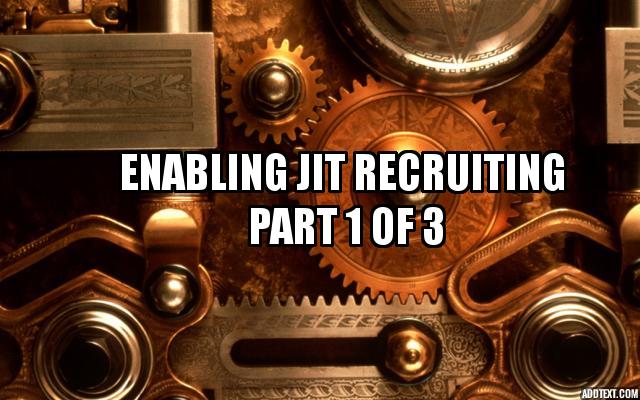
Do Be versus Be Do…How to get the transfer or promotion you want
June 5, 2017
The Power of Centralized Recruiting
March 13, 2018As the ability to identify and access candidates has grown to a point of near-transparency, recruiting enterprises are seeking systems, methods, and techniques enabling Just In Time (JIT) recruiting performance; the ability to fill requisitions when the hire is required.
In order to successfully implement a JIT recruiting model, the enterprise must first assure the real time availability of candidates with critical skills and abilities required by the organization it supports.
While this may have been possible during what I call the Procurement Era of Recruitment (2002-2014), when unemployment was so rampant that even critically skilled candidates were unemployed and available, it’s certainly no longer possible today.
That is, unless an organization is willing to convert to the use of headcount plans, rather than requisition reports, to drive the start of their candidate identification and recruitment efforts.
Requisitions…too little, too late…
Requisitions serve two basic purposes…
- They give operational and financial management the opportunity to confirm that the requirement is either back-filling a headcount loss, or is a headcount add previously approved as a function of headcount planning by the very same operational and financial management team.
- They give a hiring executive the opportunity to customize a requirement beyond the generic job description for the position.
…and that’s about it. The principal value added through the generation of a requisition is the redundant approval of a financial line item, and its use as a “duties and requirements” addendum.
Further, when you consider the fact that job offer approvals typically require the signatures of the same people who approve requisitions, it has to raise the question of why requisitions continue to exist, at all.
By requiring the same approvals for employment offers that are required for headcount plans, the need for requisitions can be eliminated entirely.
Headcount Plans: A key JIT recruitment enabler
Headcount plans are generally produced on an annual basis, and are updated on a real-time, monthly, or quarterly rolling basis throughout the year.
While headcount plans are generally created at the business unit level, they are then rolled up at the divisional and corporate level.
When positions with similar core competency requirements are rolled up at the business unit, divisional, or corporate level, the enterprise gains the ability to view its recruiting opportunity (and challenges) in a broader, more strategic manner.
The ability to literally see the desired acquisition pattern for positions requiring similar core competencies allows an organization’s HR leadership to define candidate sourcing, recruitment, and staging programs starting far in advance of any individual requirement expressed through the generation of a single requisition.
By using headcount plan roll ups to identify situations where and when groups of similar positions must be filled, even over the course of a year or more, HR management gains the ability to launch strategic recruiting efforts addressing a group of similar positions, rather than attempting to fill them using single hire sourcing efforts.
By working multiple positions, far in advance of the required date for the hire, HR can position the enterprise to optimize its return on direct contact recruitment and referral solicitation activities, while also leveraging economies of scale to reduce per-requirement sourcing costs.
Through the creation of stockpiles of available talent, by gaining an understanding of who will be available and interested, as well as when and why, the enterprise can match its known available talent supply against its known talent demand, expressed by the enterprise’s headcount plans.
In situations where it becomes clear that a shortfall is likely to exist, the enterprise can then take action, through the acquisition of additional candidate generation resources and services, to make up the shortfall. In some cases, the identification of supply shortfalls can trigger the decision to strategically approve relocation and/or external search expenditures to eliminate anticipated shortfalls.
In cases where candidate shortfalls become the rule, rather than an exception, the enterprise can use that knowledge to justify the creation of skills development/training programs, enabling the enterprise to grow its own critical talent.
At the end of the day, though, any organization seeking to optimize their potential for success as a JIT recruiting enterprise must define its sourcing strategies based on rolling, annual headcount plans, rather than real time requisition reports.
Managing “Unicorn” Requirements
One challenge to JIT recruitment is the “unicorn” requirement, so-called one of a kind, atypical hires the organization rarely makes.
Using headcount roll-ups, however, can sometimes turn a unicorn requirement into a small group of unicorns, enabling the enterprise to view it as a standard JIT sourcing challenge.
But in cases where a true unicorn requirement exists, the enterprise can prepare for the need in advance by leveraging specialty recruiting services (candidate research or search services) to deliver the advanced candidate flow required to achieve JIT grade fill performance.
Many recruiting enterprises have validated this methodology through their creation of internal executive search teams; groups of people who seek out senior management and executive level talent across functions, product operations, and divisions, whether a need for any individual candidate exists today or not.
The same search methodology can be used to address contributor level unicorn requirements.
By strategically matching sourcing and recruitment activities to the needs expressed by headcount plan roll-ups, the recruiting enterprise can bring highly skilled talent to the table very quickly, armed with the knowledge of what the candidate is looking for; what type of opportunity it would take to motivate a candidate to make a change, as well as the time frame in which they would be open to considering a move.
This ability is the core requirement for the creation of a JIT recruiting enterprise.
Managing Replacement Recruitment
When an employee resigns, a 2 week notice is generally given. Replacing employees leaving the organization is likely the greatest challenge to the JIT recruitment model, due to the difficulty of responding in a strategic manner to a tactical need.
However, if the exiting employee is part of a core skills group, the fact the enterprise will already be identifying candidate opportunities for the group will help mitigate the challenge.
In fact, the only replacement scenario representing a significant challenge to the JIT recruitment model is when a true unicorn leaves the company. But even in these instances, the need should simply be assigned to those individuals already sourcing candidates for executive, management, or contributor level unicorn roles.
Additional Benefits
There are a number of other benefits associated with the use of headcount plans, rather than requisition reports, to define and drive recruiting programs.
Motivating hiring authorities to recruit for the enterprise, rather than against a specific requisition, for example, is a tremendous benefit. Moving the enterprise toward the acquisition of candidates with critical skills aligned with the organization’s strategic, rather than tactical need, is another. The ability to proactively define higher incentives for employee referrals associated with critical areas of need is yet another benefit.
But the first step toward achieving these benefits, as well as that of JIT grade fill performance, is the use of rolling headcount plans for the enterprise. If your recruiting enterprise is waiting on the generation of a requisition to trigger critical candidate sourcing and recruiting efforts, it will inherently fail to meet the enterprise’s needs in a timely manner.
Manufacturers who implement JIT and TQM jointly outperform organizations that only pursue one, or none, of these strategies.
For more information: Total Quality Management (TQM): Your best path to sustainable recruiting excellence.

